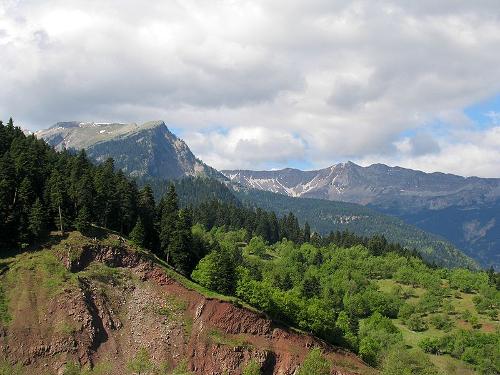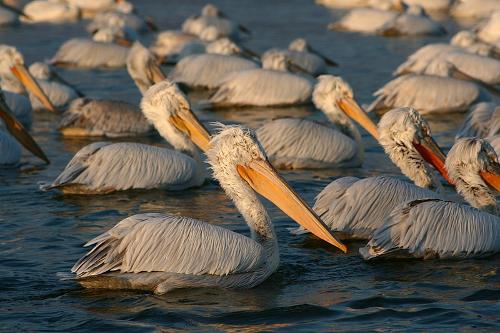GREECE
Plants and Animals

Plants and Animals
Cities in GREECE
| Athens |
Popular destinations GREECE
| Aegina | Alonissos | Andros |
| Chios | Corfu | Crete |
| Hydra | Kalymnos | Karpathos |
| Kefalonia | Kos | Lefkas |
| Lesbos | Mykonos | Naxos |
| Paros | Patmos | Peloponnese |
| Poros | Rhodes | Samos |
| Santorini | Skiathos | Skopelos |
| Spetses | Thasos | Zakynthos |
Plants and Animals
Plants
The Greek flora includes at least 6,000 species, of which about 800 are found only in that country.
 Forests Pindos mountains, GreecePhoto: George Terezakis CC 2.0 Generic no changes made
Forests Pindos mountains, GreecePhoto: George Terezakis CC 2.0 Generic no changes made
Long ago Greece was a very wooded country. As a result of large-scale deforestation and over-exploitation carried out by man and grazing by goats and sheep, only a fraction of this remains. This allowed erosion to strike unimpeded, which led to mountain soils with a thin layer of weathering material where hardly any trees can grow anymore. The existing forests are now protected by the government and reforestation is now taking place on a large scale.
Most forests can still be found in the Pindos Mountains, the slopes of which are mainly covered with Greek fir and Corsican pines. Below 1200 meters we mainly find evergreen holm oaks, chestnut trees, Aleppo pine, pine and hornbeam trees. Along the rivers there are plane trees and poplars and below 500 meters grow vine and olive tree with in between maquis (Greek: lóngos), dense thickets that reach two to six meters high. In hilly areas you often see strawberry trees, box trees, cypresses, carob trees, bay trees, myrtle and black pine. Broom turns many slopes yellow in spring, and cacti, palms and agaves are also striking appearances.
On dry limestone slopes and on many islands, the maquis turns into garrigue (fryganá), a jumble of thorny shrubs and fragrant herbs like thyme and lavender. On the steep slopes in Northern Greece there is sufficient rainfall for the kermesik, the beech and the juniper.
 Olive trees GreecePhoto: Dennis Kouto CC 3.0 Unported no changes made
Olive trees GreecePhoto: Dennis Kouto CC 3.0 Unported no changes made
The olive tree is the most striking tree in the Greek landscape. This tree has provided wood and food for humans and animals for millennia. Corfu is covered for 30% with about 4 million olive trees.
About one in eight plant species in Greece is native and sometimes only occurs on one island, one region or even one mountain. Only in spring can anemones, chrysanthemums, irises, daffodils, crocuses and hyacinths be seen. Daisies and poppies can also be found a little later in the year. Common herbs include thyme, basil, rosemary, lavender, sage, mint, and oregano.
Animals
Due to the lack of forests, there are few large mammals. The red deer is almost uncommon; still the deer and the chamois, and some wild goats on some islands and the wild boar. Wolves still occur in the northwest, the jackal is more common. Wildcat, stone marten, otter, badger and weasel are also still found, as well as, along the coast, the monk seal is in danger of extinction in this region. Rabbits are almost non-existent in Greece, but hares are quite common. In the north, the fairly rare siesel, a kind of squirrel, occurs.
 Pelicans greecePhoto: RoubiinakiM CC 4.0 International no changes made
Pelicans greecePhoto: RoubiinakiM CC 4.0 International no changes made
The number of bird species in Greece is about 400, partly because Greece is on a migration route. In the mountains you can see stone, snake and dwarf eagles, vultures and smaller birds of prey. Of the 39 bird of prey species found in Europe, as many as 36 have been seen in Dadia forest north of the Evros Delta near the Turkish border; including the griffon vulture, the Egyptian vulture, the Balkan sparrow and the very rare black vulture in Europe. The rare Eleonora's falcon lives on an island like Lesbos. Common birds are owls, including the eagle owl, kingfisher, hoopoe, oriole, woodpecker, bee-eater and roller. River deltas or "wetlands" are home to many wading and water birds such as cormorants, ibises, spoonbills, redshanks, rare frizzy pelicans near the Prespa lakes near the Albanian border, storks and flamingos. Greece is also a frequently used stopover for migratory birds on their way to North Africa in particular. Crete in particular is ideally located between Africa and the European mainland.

Tortoise GreecePhoto:Kernpanik CC 4.0 International no changes made
Special animals are the Greek tortoise, the Spurr-tighed tortoise and the only Greek tortoise Testudo marginata; unfortunately there are fewer and fewer of these species. Frogs, toads and non-poisonous snakes are everywhere, as are geckos, chameleons and other lizards. On insects and beetles we find many types of grasshoppers, dung beetles, noisy cicadas, scorpions, centipedes. Greece also has one poisonous spider species.
Sea dwellers include swordfish, mackerel, tuna and sardine, sharks, lobsters, squid, shellfish and sponges. Lakes and mountain streams are home to carp, eels and freshwater crayfish. Large numbers of sea urchins are found on the rocky coasts. Dolphins are becoming increasingly rare in the waters around Greece.
In addition to pets such as cats and dogs, almost every family in the countryside has one or more goats and / or sheep, which provide the rural population with milk, cheese (féta) and wool. The number of sheep and goats is more than 10 million. Donkeys, mules and horses are still often used in difficult terrain.
There are three national parks with a total area of approximately 52,000 hectares and some nature reserves on some islands. The state of maintenance of these areas leaves a lot to be desired.
Sources
DuBois, J. / Greece
Times Books International
Europese Unie : vijftien landendocumentaties
Europees Platform voor het Nederlandse Onderwijs
Gerrard, M. / Griekenland
Kosmos-Z&K
Koster, D. / Griekenland
ANWB
CIA - World Factbook
BBC - Country Profiles
Copyright: Team The World of Info